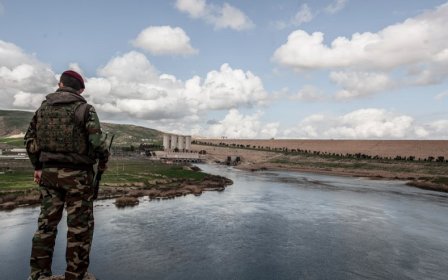Engineers fear Mosul dam collapse could kill 'more than a million'

Iraqi engineers involved in the construction and maintenance of the Mosul dam in the 1980s have said they fear the structure could collapse within weeks, causing catastrophic flooding that could kill more than one million people.
The Iraqi government on Sunday publicly acknowledged for the first time that the dam was at risk of collapsing and said that a subsequent flood could inundate nearby Mosul before sending an "inland tidal wave" surging down the Tigris river as far as Baghdad, 400kms to the south.
The US embassy also said that the dam, which has required constant maintenance since 1986 because of structural flaws in its foundations, faced “a serious and unprecedented risk of catastrophic failure with little warning” and suggested that a breach could put up to 1.47 mn lives at risk.
But a former chief engineer for the dam told the UK’s Guardian newspaper on Wednesday that the Iraqi government’s advice to residents living along the Tigris to move at least six kilometres from the river and its tributaries and seek higher ground was “ridiculous”.
“Nobody knows when it will fail. It could be a year from now. It could be tomorrow,” said Nasrat Adamo, who is now an engineering consultant in Sweden.
“If the dam fails, the water will arrive in Mosul in four hours. It will arrive in Baghdad in 45 hours. Some people say there could be half a million people killed, some say a million. I imagine it will be more in the absence of a good evacuation plan.”
The Iraqi government has sought to play down the dangers posed by the dam with Sunday’s statement issued by Iraqi Prime Minister Haider al-Abadi’s office describing the possibility of collapse as “very unlikely”.
Officials also told Middle East Eye that the situation was under control.
"Maintenance work is ongoing, the situation is under control and the current inventory is equivalent to just one-third of the tank's capacity,” said Mahdi Rasheed, the general director of the Iraqi Dams Company.
"The [contingency] plan is a routine warning to educate people about this issue, so people will be sure that everything will be okay."
Iraq's Ministry of Water Resources, which is in charge of the country’s dams, has also played concerns and argued that similar warnings had been issued in 2005, 2006 and 2007.
“The dam will be safe as long as the water level is low,” it said.
But an extensive investigation conducted earlier this month by the parliamentary committee of water and agriculture concluded that water levels were expected to rise significantly in March and April and that the “stress on the dam will be increased”.
Adamo said that maintenance work to ensure the structural safety of the dam required at least 300 people working 24 hours a day over three shifts, but that a full workforce with the required machinery had not been in place since the dam was briefly captured by the Islamic State (IS) group in 2014, which still controls nearby Mosul.
"There are perhaps 30 people there now,” he said. “The machines for grouting have been looted. There is no cement supply. They can do nothing. It is going from bad to worse, and it is urgent. All we can do is hold our hearts.”
The Iraqi government has appointed TREVI, an Italian engineering firm, to carry out emergency maintenance work, but some fear the situation may already be out of control.
Nadhir al-Ansari, who worked on the construction of the dam and is now an engineering professor in Sweden, said that rising water levels in April and May caused by melting snow posed a further problem.
“The fact that the bottom outlets are jammed is the thing that really worries us,” he said. “The water level is now 308 metres but it will go up to over 330 metres… I don’t think the dam will withstand that pressure.”
Ansari said that construction of the dam was pushed through despite concerns about the water-soluble bedrock on which it was built because consultants said the structural weakness could be addressed by constant concrete grouting.
Water began seeping through soon after the dam opened in 1986 when it became apparent that the geological issues were worse than had been predicted.
Construction of a second nearby dam intended to prevent a disaster if the Mosul dam failed started in 1988 but the project stalled in 1991 because of economic sanctions imposed on Iraq as a result of the first Gulf War.
Stay informed with MEE's newsletters
Sign up to get the latest alerts, insights and analysis, starting with Turkey Unpacked
Middle East Eye delivers independent and unrivalled coverage and analysis of the Middle East, North Africa and beyond. To learn more about republishing this content and the associated fees, please fill out this form. More about MEE can be found here.





